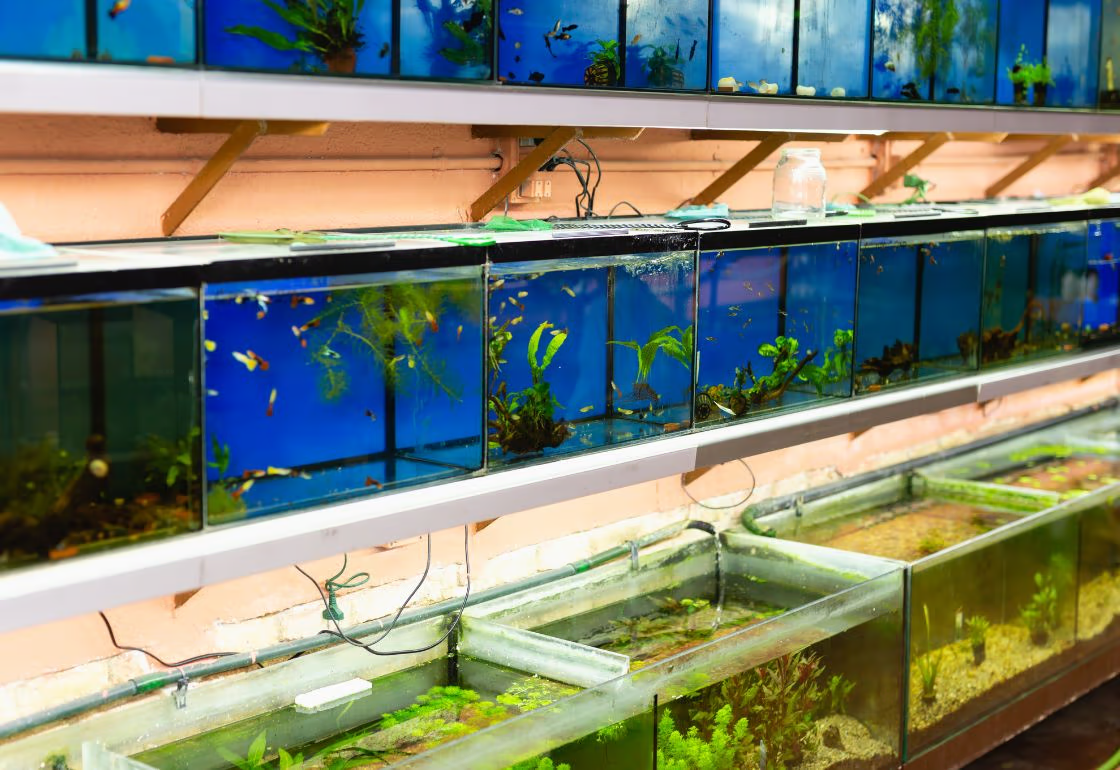The bright shimmer of neon tetras. The bold stripes of discus. The sheer variety of imported tropical fish is enough to stop anyone in their tracks. It’s no wonder pet stores lean on these beauties to attract customers. Their exotic colors and rare shapes make them irresistible to hobbyists, collectors, and even first-time aquarium owners. But here’s the catch—what looks beautiful in a display tank often comes with hidden baggage.
Behind every imported fish is a trail of unseen costs: shipping stress, higher mortality, disease risk, environmental damage, and complicated regulations. Pet stores eager to satisfy demand can easily overlook these issues, but ignoring them can chip away at profits, reputation, and even legal standing.
This isn’t just about moving fish from one country to another—it’s about responsibility, sustainability, and protecting the industry we all love. Let’s dig deeper into The Hidden Cost of Imported Tropical Fish: What Every Pet Store Should Know.
The Allure of Imported Tropical Fish
So, why do stores keep importing fish despite the challenges? It’s simple—customers want them.
- Exotic appeal: Imported fish often boast brighter colors, unusual patterns, and species that hobbyists can’t find locally. They add “wow” factor to tanks, making them instant sellers.
- Rare availability: Collectors and enthusiasts love having species that aren’t common in domestic breeding. Think wild-caught cichlids from Africa’s rift lakes or delicate dwarf shrimp from Asia.
- Marketing advantage: A store that can claim “exclusive” or “hard-to-find” fish stands out from competitors. Unique stock can drive foot traffic and online sales alike.
There’s no denying imported tropical fish have their place. But here’s the trade-off—while they boost sales upfront, they also bring risks that don’t always show up on the invoice. And when you start tallying everything, the real price becomes clear.
The Financial Costs That Add Up
Imported tropical fish are rarely cheap, even before you put them in the tank. The financial toll stacks up quickly:
- Shipping and handling fees
International shipping isn’t as simple as slapping a label on a box. Live animals need oxygenated bags, insulated containers, heat or cold packs depending on the season, and fast transit to minimize stress. Airlines charge premium rates for live cargo, and delays at customs can add even more to the bill. - Quarantine and acclimation
You can’t just drop imports straight into a sales tank. Stores need extra tanks for quarantine, proper filtration, and trained staff to watch for signs of stress or illness. That means extra labor hours, water treatment, and medication—all before a fish is even available for sale. - Mortality rates
Sadly, not every fish makes it. Imports are more likely to arrive weakened or stressed from capture and shipping. Even with the best handling, mortality rates can run higher than with locally bred fish. Each loss is money down the drain—literally. - Cost comparison
Locally bred fish, while sometimes higher per unit, often prove more cost-efficient. Lower mortality, less acclimation, and reduced shipping hassles mean the profit margins are often stronger in the long run.
We’ve learned firsthand—cutting corners on imports can cost more than the fish themselves. Smart pet stores crunch these numbers before deciding whether “rare” is worth it.
The Ethical and Environmental Concerns
Here’s a side most customers never see: the environmental impact of catching fish in the wild.
- Overfishing: Some species are collected faster than they can repopulate. That puts entire populations at risk.
- Ecosystem damage: Removing too many fish disrupts natural food chains. Collecting from coral reefs or river systems can cause long-term harm.
- Stress and poor conditions: From capture to transport, fish are often handled in ways that compromise their health. Long journeys in cramped bags, sudden temperature changes, and minimal feeding leave them fragile before they ever reach a tank.
Pet stores are the final stop in this chain, which means they also play a role in either supporting or reducing these harms. Stocking wild-caught imports without considering sustainability contributes to the cycle. On the other hand, supporting captive-bred programs and sustainable suppliers helps preserve the habitats that give us these fish in the first place.
At Top Quality, we take pride in balancing beauty with responsibility. It’s not just about what’s in the tank—it’s about protecting what’s in the rivers and reefs, too.
Regulatory and Legal Risks
Importing tropical fish isn’t just about picking species and placing orders. It’s wrapped in red tape.
- Import laws and permits: Many species fall under CITES (the Convention on International Trade in Endangered Species), which requires strict documentation. Slip-ups can lead to delays, fines, or confiscated shipments.
- Customs checks: Countries impose different health and safety requirements. A fish that passes in one country may be restricted in another.
- Invasive species concerns: If a customer releases a non-native fish into local waterways, the results can be devastating. Florida alone has seen entire ecosystems disrupted by invasive cichlids and plecos. Pet stores can be indirectly tied to these introductions.
Compliance isn’t optional—it’s survival. A single mistake can cost a business thousands, not to mention its reputation. That’s why experience matters. At Top Quality Enterprises Inc., we follow every regulation to the letter, ensuring shipments move smoothly for both domestic and international clients.
Health and Disease Risks
Perhaps the most costly and frustrating hidden cost—disease.
Imported fish often arrive carrying parasites, bacterial infections, or fungal problems. Even if the fish looks fine, stress can weaken its immune system, allowing illness to take hold later.
The ripple effect is enormous:
- Treatment costs: Medications, water changes, and staff time add up quickly.
- Losses: One outbreak can wipe out entire tanks.
- Customer trust: If a customer buys a fish that spreads disease to their aquarium, you’re not just losing a sale—you’re losing their trust and potentially dozens of future customers.
This is why quarantine protocols aren’t just nice to have—they’re essential. Pet stores that treat them as optional often end up paying the price in wasted stock and angry customers.
The Business Case for Local and Sustainable Alternatives
Now for the brighter side: alternatives do exist. And they often work out better for everyone.
- Lower mortality rates: Locally bred fish are healthier and better adapted to controlled tank life. They don’t endure long shipping journeys, so they arrive stronger.
- Healthier stock: Fish bred in captivity are often disease-free and easier to acclimate.
- Supplier relationships: Working with local breeders builds strong networks, better pricing options, and consistent supply.
- Marketing advantage: Customers are increasingly eco-conscious. Advertising “locally bred, sustainable tropical fish” can boost sales and set your store apart.
At Top Quality, we’ve built long-term partnerships with breeders and sustainable suppliers around the world. Our customers benefit from healthier fish, reliable shipments, and the peace of mind that they’re making ethical choices.
Practical Tips for Pet Store Owners
If you’re running or managing a pet store, here are some real-world steps to protect both your business and your customers:
- Vet your suppliers carefully – Don’t just go for the cheapest option. Ask about collection methods, mortality rates, and disease prevention protocols.
- Invest in quarantine systems – Even the best imports need a buffer before they hit display tanks. Quarantine prevents problems from spreading.
- Educate your customers – Teach hobbyists about the importance of sustainable fishkeeping. Offer guides, workshops, or simple signage in your store.
- Consider captive-bred first – Stock more captive-bred species to reduce reliance on risky imports. Highlight these in your marketing.
These aren’t just good practices—they’re smart business moves. Stores that earn reputations for quality, healthy fish attract loyal customers who come back again and again.
Why the Real Cost Matters More Than the Price Tag
The shimmering scales and rare species of imported tropical fish may grab attention, but the hidden costs can’t be ignored. From financial strain to ethical dilemmas, from regulatory headaches to health risks, the real price of imports goes far beyond the purchase invoice.
For pet store owners, the path forward is about balance. Imports will always have a role in the trade, but local and sustainable sourcing offers stability, healthier stock, and stronger profits in the long run.
At Top Quality Enterprises Inc., we’ve built our reputation on delivering not just fish, but trust, knowledge, and care. Whether you’re a local pet store in Tampa Bay or a buyer across the globe, we provide healthy, high-quality tropical fish backed by over a century of combined experience.
If you’re ready to stock your tanks with tropical fish that arrive healthy, happy, and responsibly sourced, reach out to Top Quality Enterprises Inc. today. Let’s work together to bring beauty to your store—and peace of mind to your business.

